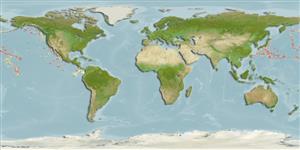Holocéphales (chimères) (chimaeras) >
Chimaeriformes (Chimaeras) >
Chimaeridae (Shortnose chimaeras or ratfishes)
Etymology: Hydrolagus: hydro-, combining form of hydor (Gr.), water; lagos (Gr.), hare, i.e., “water rabbit,” probably referring to three pairs of tooth plates, which tend to protrude from the mouth like a rabbit’s incisors (See ETYFish); purpurescens: Latin for purple-tinged, referring to its purplish or plum color (See ETYFish).
More on author: Gilbert.
Environment: milieu / climate zone / depth range / distribution range
Écologie
marin bathydémersal; profondeur 1150 - 1951 m (Ref. 58302). Temperate
Pacific Ocean: Japan and the Hawaiian Islands.
Taille / Poids / Âge
Maturity: Lm ? range ? - ? cm
Oviparous (Ref. 205). Eggs are encased in horny shells (Ref. 205).
Life cycle and mating behavior
Maturité | Reproduction | Frai | Œufs | Fécondité | Larves
Nakaya, K., 1984. Chimaeridae. p. 17. In H. Masuda, K. Amaoka, C. Araga, T. Uyeno and T. Yoshino (eds.) Fishes of the Japanese Archipelago. Tokai Univ. Press, Tokyo, Japan. 437 p, 370 pls. (Ref. 11099)
Statut dans la liste rouge de l'IUCN (Ref. 130435: Version 2024-2)
Menace pour l'homme
Harmless
Utilisations par l'homme
Outils
Articles particuliers
Télécharger en XML
Sources Internet
Estimates based on models
Preferred temperature (Ref.
123201): 1.4 - 1.7, mean 1.5 °C (based on 499 cells).
Phylogenetic diversity index (Ref.
82804): PD
50 = 0.5000 [Uniqueness, from 0.5 = low to 2.0 = high].
Bayesian length-weight: a=0.00331 (0.00137 - 0.00798), b=3.07 (2.86 - 3.28), in cm total length, based on LWR estimates for this (Sub)family-body shape (Ref.
93245).
Niveau trophique (Ref.
69278): 3.9 ±0.6 se; based on size and trophs of closest relatives
Résilience (Ref.
120179): Faible, temps minimum de doublement de population : 4,5 à 14 années (Assuming Fec <100).
Fishing Vulnerability (Ref.
59153): Moderate to high vulnerability (54 of 100).
